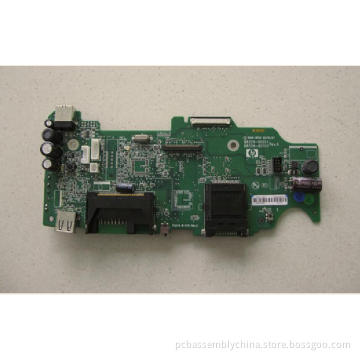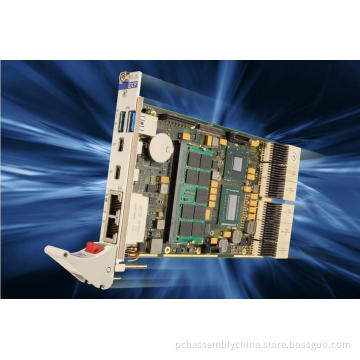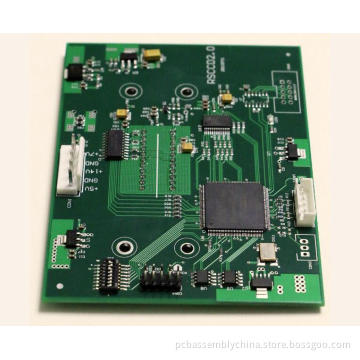
aerospace Militarized C4 systems pcb assembly
Your message must be between 20 to 2000 characters
Contact NowAerospace defence military equipment Militarized C4 systems product pcba motherboards assembly electronics OEM contract manufacturing assembly services OEM CEM EMS experience company-China Shenzhen Topscom

General Dynamics Mssion Systems Electronic OEM EMS CEM Contract Manufacturing pcb assembly service:
Microelectromechanical systems (MEMS, also written as micro-electro-mechanical, MicroElectroMechanical or microelectronic and microelectromechanical systems and the related micromechatronics) is the technology of microscopic devices, particularly those with moving parts. It merges at the nano-scale into nanoelectromechanical systems (NEMS) and nanotechnology. MEMS are also referred to as micromachines in Japan, or micro systems technology (MST) in Europe.
MEMS are separate and distinct from the hypothetical vision of molecular nanotechnology or molecular electronics. MEMS are made up of components between 1 and 100 micrometres in size (i.e. 0.001 to 0.1 mm), and MEMS devices generally range in size from 20 micrometres to a millimetre (i.e. 0.02 to 1.0 mm). They usually consist of a central unit that processes data (the microprocessor) and several components that interact with the surroundings such as microsensors.At these size scales, the standard constructs of classical physics are not always useful. Because of the large surface area to volume ratio of MEMS, surface effects such as electrostatics and wetting dominate over volume effects such as inertia or thermal mass.
The potential of very small machines was appreciated before the technology existed that could make them (see, for example, Richard Feynman's famous 1959 lecture There's Plenty of Room at the Bottom). MEMS became practical once they could be fabricated using modified semiconductor device fabrication technologies, normally used to make electronics. These include molding and plating, wet etching (KOH, TMAH) and dry etching (RIE and DRIE), electro discharge machining (EDM), and other technologies capable of manufacturing small devices. An early example of a MEMS device is the resonistor – an electromechanical monolithic resonator.
General Dynamics Mission Systems is a business unit of American defense and aerospace company General Dynamics. General Dynamics Mission Systems integrates secure communication and information systems and technology. General Dynamics Mission Systems has core manufacturing in secure communications networks; radios and satellite technology for the defense, cyber, public safety, and intelligence communities.
LTE
General Dynamics Mission Systems has the Cell on Wheels (COW), a deployable emergency LTE solution, that is used by first responders and other public safety officials. It is a mobile cell tower, able to cover about six square miles. This network was created in 2013.
Fortress LTE technology includes Virtual Core Network (vCN), eNodeB Base Stations, LTE Band 14 Outdoor Omni-Directional User Equipment, C-Band LTE User Equipment, LTE USB Stick Modem. 4G Evolved Node B (eNodeB) base stations are software defined radios that house both digital baseband and Radio Frequency (RF) circuits in a compact, rugged, mountable enclosure to eliminate external interfaces and reduce installation errors and setup time. A range of eNodeB form factors are offered for different deployment scenarios and support standard 4G LTE band classes and frequency ranges from 400 MHz to 6 GHz. Virtual Core Network (VCN) is virtual 4G core network that can be deployed on a wide range of COTS computing platforms. The VCN is an Evolved Packet Core (EPC) solution.
Cyber
Cyber Defense products include: TACLANE Network Encryptors, ProtecD@R Data-at-Rest Encryptors, GEM X™ Encryptor Manager and Pitbull Operating System.
Imaging Technologies
EO/IR Gyro-Stabilized Camera Systems (V-Series) is one of the systems offered in General Dynamics Mission Systems' imaging technologies and has searchlight controls, laser illuminating and geo-pointing functions. Cineflex is a division of General Dynamics Mission Systems. They have camera systems that have a five-axis gyro-stabilized gimbal.
Maritime and Strategic Systems
General Dynamics Mission Systems acquired Bluefin Robotics in February 2016. They are a manufacturer of unmanned undersea vehicles (UUVs) that perform a wide range of missions for the U.S. military and commercial customers.
The Independence-variant Littoral Combat Ship (LCS) is built on General Dynamics Mission Systems open architecture computing infrastructure (OPEN CI). Austal has been contracted to build for the U.S. Navy as prime contractor subsequent to a $3.5 billion block buy in 2010.
Radio Communications
The CM-300/350 Series Version 2 radios are the latest additions to the Air Traffic Control (ATC) radios. Based on the FAA NEXCOM Segment 2 radio requirements, these rack mounted transmitter and receiver systems are specifically designed to meet the dynamic mission requirements of air traffic control centers, commercial airports, military air stations and range installations.
MeerKAT Radio Telescope
SATCOM
The MeerKAT telescope array, a precursor telescope to South Africa`s planned Square Kilometer Array (SKA), comprises 64 radio antennas in South Africa`s Northern Cape Province. When completed in 2016, MeerKAT will be the largest most powerful radio telescope in the Southern Hemisphere until the SKA array is completed in 2024. MeerKAT covers eight kilometers and will facilitate research into cosmic magnetism, galactic evolution, and the large-scale structure of the cosmos, dark matter and the nature of transient radio sources among other science projects.
Space
General Dynamics Mission Systems provides the integrated ground segments for the Mobile User Objective System (MUOS) that is being used by the U.S. Navy, which will soon provide cell phone-like communications for warfighters on the move.
WIN-T Program
WIN-T: Warfighter Information Network-Tactical (WIN-T) is the Army's tactical communications system. General Dynamics is the Army's prime contractor for WIN-T, which is part of General Dynamics Mission Systems' tactical voice and data communications systems, The Soldier's Network. Increment 1, now fully deployed, began fielding in 2004 and completed fielding in 2012. In November 2007, General Dynamics announced a $78 million order on an indefinite delivery and quantity contract for WIN-T Increment 1. In April 2015, General Dynamics Mission Systems was awarded a $36 million army contract for maintenance and repair of all products related to Increment 1. In June 2015, General Dynamics secured a contract for Increment 2, valued at $219 million.[17] Increment 2 includes additional capabilities, such as mobile broadband. Increment 1 and 2 equipment will remain in the field at the battalion and company levels as Increment 3 is completed.
Related Keywords










